The Overexpression of Acyl-CoA Medium-Chain Synthetase-3 (ACSM3) Suppresses the Ovarian Cancer Progression via the Inhibition of Integrin β1/AKT Signaling Pathway
- PMID: 33869039
- PMCID: PMC8045751
- DOI: 10.3389/fonc.2021.644840
The Overexpression of Acyl-CoA Medium-Chain Synthetase-3 (ACSM3) Suppresses the Ovarian Cancer Progression via the Inhibition of Integrin β1/AKT Signaling Pathway
Abstract
Ovarian cancer is considered as one of the most fatal gynecologic malignancies. This work aimed to explore the effects and regulatory mechanism of Acyl-CoA medium-chain synthetase-3 (ACSM3, a subunit of CoA ligases) in ovarian cancer progression. As well as employing CCK-8 assay, clone formation assay, and cell cycle analysis were carried out to investigate cell proliferation ability. Wound healing assay and transwell assay were subsequently used to assess cell migration and invasion. Mice xenografts were then conducted to measure the effects of ACSM3 on tumor development in vivo. Our bioinformatics analysis suggested that the expression of ACSM3 was down-regulated in ovarian cancer tissues, and the low expression level of ACSM3 might related with poorer overall survival than high mRNA expression of ACSM3 in ovarian cancer patients. We artificially regulated the expression of ACSM3 to evaluate its effects on ovarian cancer malignant phenotypes. Our data revealed that the overexpression of ACSM3 inhibited cell proliferation, migration, and invasion of ovarian cancer cells. In contrast, the knock-down of ACSM3 received the opposite results. Our western blot results showed that the Integrin β1/AKT signaling pathway was negatively regulated by ACSM3 expression. Moreover, ACSM3 overexpression-induced suppression of cell migration and invasion activities were abolished by the overexpression of ITG β1 (Integrin β1). Additionally, the growth of ovarian cancer xenograft tumors was also repressed by the overexpression of ACSM3. And ACSM3 interference obtained the contrary effects in vivo. In summary, ACSM3 acts as a tumor suppressor gene and may be a potential therapeutic target of ovarian cancer.
Keywords: acyl-CoA medium-chain synthetase-3; integrin β1; metastasis; ovarian cancer; proliferation.
Copyright © 2021 Yan, He, Li, Liu and Gao.
Conflict of interest statement
The authors declare that the research was conducted in the absence of any commercial or financial relationships that could be construed as a potential conflict of interest.
Figures

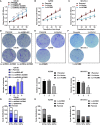
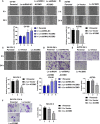
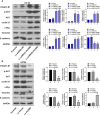
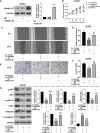
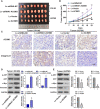
Similar articles
-
KLF10 upregulates ACSM3 via the PI3K/Akt signaling pathway to inhibit the malignant progression of melanoma.Oncol Lett. 2022 Jun;23(6):175. doi: 10.3892/ol.2022.13295. Epub 2022 Apr 13. Oncol Lett. 2022. PMID: 35497935 Free PMC article.
-
ACSM3 Suppresses Ovarian Cancer Progression by Inactivating the IFN-γ/JAK/STAT3 Signaling Pathway.Adv Biol (Weinh). 2025 Mar;9(3):e2400093. doi: 10.1002/adbi.202400093. Epub 2025 Feb 6. Adv Biol (Weinh). 2025. PMID: 39913127
-
Downregulation of ACSM3 promotes metastasis and predicts poor prognosis in hepatocellular carcinoma.Am J Cancer Res. 2017 Mar 1;7(3):543-553. eCollection 2017. Am J Cancer Res. 2017. PMID: 28401010 Free PMC article.
-
Acyl-CoA Medium-Chain Synthetase-3 (ACSM3) Is Regulated by Insulin Like Growth Factor 2 mRNA Binding Protein 3 (IGF2BP3) and Inhibits Proliferation, Motility and Stem Cell Properties of Breast Invasive Carcinoma.Ann Clin Lab Sci. 2023 Jul;53(4):539-547. Ann Clin Lab Sci. 2023. PMID: 37625834
-
ACSM3 suppresses proliferation and induces apoptosis and cell cycle arrest in acute myeloid leukemia cells via the regulation of IGF2BP2.Exp Ther Med. 2023 Mar 8;25(4):177. doi: 10.3892/etm.2023.11876. eCollection 2023 Apr. Exp Ther Med. 2023. PMID: 37006876 Free PMC article.
Cited by
-
Identification of the Immune Signatures for Ovarian Cancer Based on the Tumor Immune Microenvironment Genes.Front Cell Dev Biol. 2022 Mar 17;10:772701. doi: 10.3389/fcell.2022.772701. eCollection 2022. Front Cell Dev Biol. 2022. PMID: 35372348 Free PMC article.
-
Study of prognostic splicing factors in cancer using machine learning approaches.Hum Mol Genet. 2024 Jun 21;33(13):1131-1141. doi: 10.1093/hmg/ddae047. Hum Mol Genet. 2024. PMID: 38538560 Free PMC article.
-
Acyl-CoA Synthetase Medium-Chain Family Member 5-Mediated Fatty Acid Metabolism Dysregulation Promotes the Progression of Hepatocellular Carcinoma.Am J Pathol. 2024 Oct;194(10):1951-1966. doi: 10.1016/j.ajpath.2024.07.002. Epub 2024 Jul 26. Am J Pathol. 2024. PMID: 39069168
-
Acquisition of taxane resistance by p53 inactivation in ovarian cancer cells.Acta Pharmacol Sin. 2022 Sep;43(9):2419-2428. doi: 10.1038/s41401-021-00847-6. Epub 2022 Jan 14. Acta Pharmacol Sin. 2022. PMID: 35031699 Free PMC article.
-
KLF10 upregulates ACSM3 via the PI3K/Akt signaling pathway to inhibit the malignant progression of melanoma.Oncol Lett. 2022 Jun;23(6):175. doi: 10.3892/ol.2022.13295. Epub 2022 Apr 13. Oncol Lett. 2022. PMID: 35497935 Free PMC article.
References
LinkOut - more resources
Full Text Sources
Other Literature Sources
Research Materials

